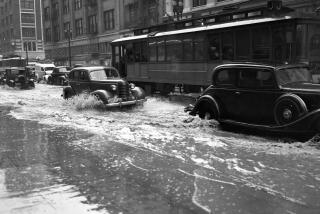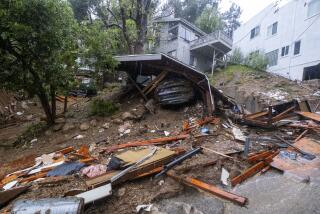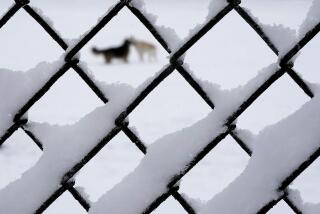Weathering Winter Without TV Meteorologists, Snow...
ALBANY, N.Y. — They did it without road salt or electric blankets, without television meteorologists, forecasting satellites or snow blowers--and, especially, without automobiles.
Somehow, people 100 or 200 years ago managed to weather winter without most of the “conveniences” considered indispensable today. In many ways, they handled the season better than we do.
“There was an acceptance of the winter, and a willingness to work with whatever the weather brought you,” said Katie Boardman, associate director of the Farmers’ Museum in Cooperstown. “I think that was because people’s daily lives were so much more connected to nature and the elements than we are today.”
The dread of a winter commute that millions of motorists feel today, for instance, was just the opposite in the pre-automobile age. Without the muck of fall and the even worse mire of spring, winter was regarded as the most dependable season for travel in the horse-powered era, experts said.
“Because of our road network today, we feel winter must have been much more difficult in those days,” said Charles Gehring, a New York State Museum expert on the Dutch settlers of the 17th and 18th Centuries.
“But back then, it was so much more advantageous, because you didn’t have these huge, muddy ruts in the roads during the winter,” Gehring said. Heavy items, in particular, were easier to move on the hard winter ground.
The horse-drawn sleigh was the most popular means of winter transportation before the automobile. Roads were often rolled after snowstorms by teams of oxen or horses, creating a smooth carpet of ice for sleighs’ runners.
People still died or were injured when sleighs overturned, and they risked exposure if they were stranded by drifts or injuries to their horses. But the sleighs were still probably just as safe, if not safer, than fast cars on crowded, snowy roads, experts said.
Winter was often a social time too. With farm chores limited by the snow, people had more time for visiting.
People were adept at stocking up for winter by canning vegetables, curing meats and drying fruits, Boardman said. They amassed supplies of firewood. They “piled their clothes on and kept them on, even indoors,” Boardman said.
“People 100 years ago were much more self-reliant,” said Tim Clark, executive editor of the Old Farmer’s Almanac. “That’s not to say they were any more virtuous, but back then they had to fend for themselves in weather like this.”
They usually had the advantage of not having to leave home, for days or even weeks if necessary, during dangerous storms or cold snaps.
The first crude motorized snowplows appeared in the 1920s and 1930s, according to Duane Amsler, an engineer with the New York Department of Transportation. Road salt came along after World War II.
During those decades, there was a gradual shift in the pattern of life in New York and the rest of the United States. People moved from cities and farms to the suburbs.
Instead of walking to the office or the barn, people had to drive to work from the suburbs, Amsler said. People demanded an all-weather highway system and came to expect to roll out of bed and to get to work in more or less the same time, whether it be sunny or snowy.
That is a kind of presumptuous attitude toward nature that most people in the pre-automobile age did not have, experts said.
“People looked at the clouds a lot,” Boardman said. “Many farmers looked at their almanacs. They looked at the moon cycles. They watched the plants and the animals around them to see how they were reacting. They used that information to help them know what was going to come. . . . And they were very careful about going out.”
Formal attempts to forecast the weather did not start until after the Civil War. For the next two generations those were limited by information that could be gleaned from a thermometer, a barometer, a wind gauge and telegraphic reports of conditions to the west and south.
Thus, the Blizzard of 1888, the most famous snowstorm of the 19th Century and probably in all of American history, came as a shock to everyone. That included forecasters, who predicted rainy and windy conditions, followed by clearing, as the tempest was starting to blow on March 12, 1888.
Instead, 21 inches of snow fell on New York City; nearly 50 inches on Albany. Hundreds were killed up and down the East Coast.
“You see, we know so little anyway, and there is so much more of which we are and must be ignorant,” the weather service’s organizer, Cleveland Abbe, said a few days after the 1888 blizzard. “We are utterly ignorant of what is going on to the east of us, and overhead.”
Most of those killed in the Great Blizzard were in cities, especially New York, Philadelphia, Albany, New Haven, Conn., and Hartford, Conn. Typically, they ventured out in the face of the whirlwind and became trapped in 10- or 15-foot drifts while walking to catch trains or elevated railroads.
Already in 1888, some people saw in that blizzard the dangers of putting too much trust in the “advances” of technology.
“It is the boasting and progressive 19th Century that is paralyzed, while the slow-going 18th would have taken such an experience without a ruffle,” the Hartford Courant editorialized just after the blizzard. “It is our own ‘advantages’ that have gone back on us. . . . It is only a snowstorm, but it has downed us.”
A century later, wintertime continues to remind people that for all their Die-Hard batteries and four-wheel drive vehicles, for all their efforts to triumph over cold and snow, they can’t ignore the inconvenience or do much about the weather.
“Think of going back to the Bible, where we are supposedly given rule over everything,” said Mark Wysocki, a lecturer in meteorology at Cornell University. “But we don’t have rule over everything. The winter reminds us of that. It reminds us of the fact we are slaves to nature.”
More to Read
Sign up for Essential California
The most important California stories and recommendations in your inbox every morning.
You may occasionally receive promotional content from the Los Angeles Times.










